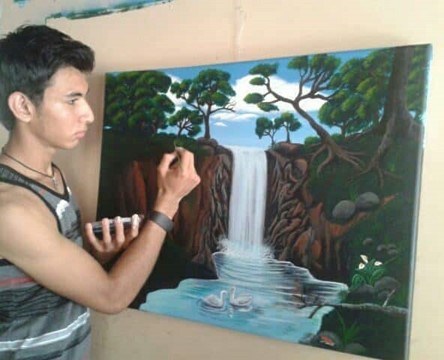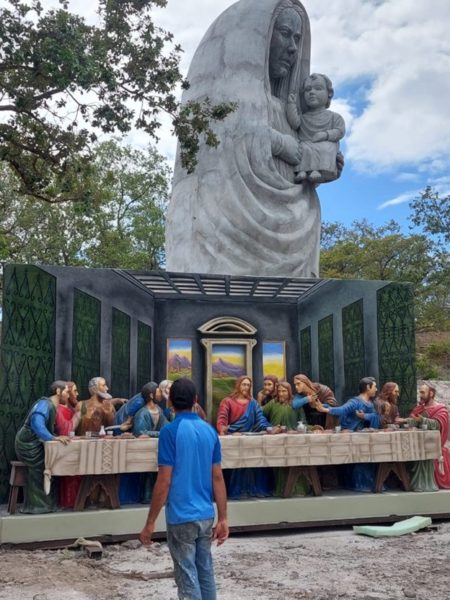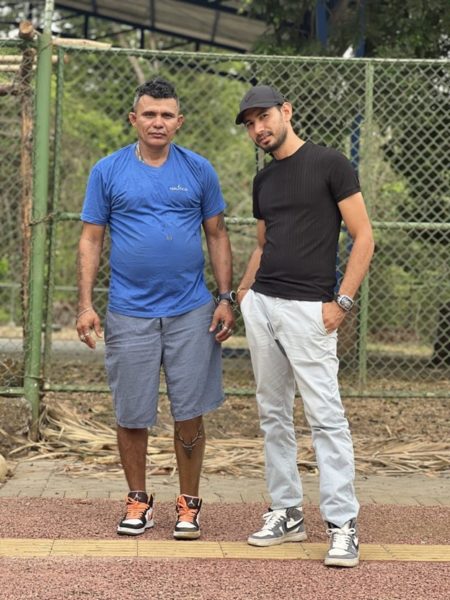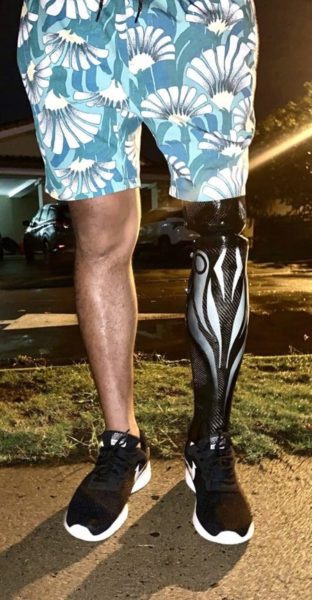Yeison Silva, the Nicaraguan Who Sculpts Prosthetic Legs

The self-taught artist emigrated to Guanacaste, Costa Rica, as a child. He has distinguished himself there as a painter and sculptor, and now as a maker of personalized prosthetic legs.
By Cindy Regidor (Confidencial)
HAVANA TIMES – He had sculpted animals, plants, fruits, and large figures; he had done high relief sculptures, but nothing like a leg. Hence Yeison Silva felt quite intimidated by the message he received from a former classmate.
His friend explained that he had lost his leg in an accident and needed a prosthesis. “Yeison, you make high-quality and very realistic sculptures, so why don’t you make me a prosthesis?” the message read. Yeison left it unanswered for some two or three months.
Then came the impulse and the determination to try: “Let’s do it. Let’s see how it comes out,” Yeison finally answered, without knowing that this would be the beginning of a new direction to his life: using his artistic talents to make personalized prostheses for the lower extremities.
His unique and high-quality designs have become sought-after in Costa Rica, which motivates him to perfect this work, creating new types of prostheses and designing low-cost models.
Yeison Silva is a self-taught painter and sculptor of Nicaraguan origin who resides in the Costa Rican city of Liberia. The city is located in Guanacaste, a province in northwest Costa Rica that borders with Nicaragua. The area is visited by hundreds of thousands of tourists every year, drawn to its beautiful beaches, volcanoes, and other natural attractions.
The story of this young man of 29 is the same tale of family and generational migration that has marked a large portion of the Nicaraguan population in Costa Rica. Originally from Leon, Nicaragua, he left the country in 2000 with his mother and siblings, all fleeing the abuses of his alcoholic father. His maternal grandmother had already settled in Sardinal de Carrillo, a small seaside town in Guanacaste province. His grandmother didn’t hesitate to invite Yeison’s mother to move there with the children and begin a new life.
That’s where Yeison grew up, surrounded and inspired by the natural abundance that characterizes Costa Rica. “It was another world …. the plants, the animals, the howler monkeys I saw all made an impression on me,” he recalls.
Yeison is grateful for the support and education he received as a child immigrant when he arrived there at six years old. He’s also grateful for his mother’s efforts to assure he got ahead, and for the state scholarships he received due to his good grades. These grants helped him finish his studies.

In addition to these factors, his teachers’ belief in him was decisive. “In school, we took art classes and there were drawing and painting contests. My teacher signed me up, because she knew I loved art. Feeling that you are part of something and that you’re admired for what you do makes you want to go higher and higher.” That’s how he grew up and began to mold himself into a self-taught artist.
The young entrepreneur
From the time he was in high school, Yeison earned his own money selling his art. He explains that he sometimes received up to 80,000 colones [about US $160 dollars at current exchange rates] for a commissioned painting.
When he reached the official working age, he began to look for a job, especially in the tourist sector which at that time had begun to grow by gigantic leaps in the zone. He applied for a job at one of the largest and most expensive hotels in the area, offering painting classes to tourists. However, he received a bitter surprise: his status as a foreigner meant he was restricted from working.
What stands out all through the interview with Yeison is the young man’s determination, clearly visible in the anecdotes he shares. When faced with a challenge or obstacle, Yeison “flies with it” as they say in Costa Rica – that is, he makes a bold move. At the same time, though, he acts both confidently and cautiously.
In the face of the legal barrier to work, people recommended to the youth that he open a company and offer his professional services through that channel. “With no fears or doubts, I registered my company,” he remembers, noting that at that moment he became an entrepreneur through accident and necessity.
Yeison also remembers how he applied to another hotel job without knowing English, even though it was a firm requirement. A friend who had experience in the position made him a list of the essential phrases for his work. He memorized them and so succeeded in holding that job giving painting classes.
His talent began bringing him more and more fame among the area’s tourists. He soon began to sign contracts to make paintings, murals, and sculptures to decorate different businesses, including hotels, parks, restaurants, and souvenir stands. Yeison assures that he long ago lost track of how many jobs of this type he’s done, some in collaboration with other artists, among them another Nicaraguan sculptor – Ricardo Lira Lopez.
“The first sculptures were a disaster, but I said: Okay, I have to get the hang of this deal.” I took it on, I learned it on the spot, and I did it,” he says.



Turning his sculptor’s talents to legs
The message he received from the former classmate who had lost his leg made Yeison thoughtful. “I said to myself: ‘I’m fearful. It’s a type of work that not just anyone can do,’” he tells us. In the end, though, he accepted the request. The prothesis turned out well and everyone liked it, Yeison asserts, adding that even an orthopedic center in Guanacaste contacted him.
His wife Lilia, who is also a painter and who speaks Mandarin Chinese suggested to him that he become more involved in the fabrication of prosthetic legs, by contacting Chinese companies who might be interested in importing his products. In that way, they’ve made dozens since they began in 2022.


Yeison buys the pieces, assembles them, then adapts the design however the client wishes. Some ask for futuristic or robotic styles, others for specific details related to their personal passions or favorite animals. Many others want the prosthesis to look like a real leg. He’s very careful with the measurements and weight, because he knows these qualities impact the physique of the person wearing the device. “Everyone walks differently, each step is different. I adapt the prosthesis until the person feels comfortable, as if the prosthesis were part of them. If it’s too high or too low it can cause damage to the spine,” he explains.
A basic prosthesis subsidized by Costa Rica’s public health system can cost more than 300,000 colones (US $600), but it’s not very functional, says Yeison. On the open market, a quality prosthesis can cost between US $5,000 – $6,000 dollars, or even up to US $15,000.
The artist feels satisfied knowing that his clients can resume many of their daily activities, thanks to the functionality of the prosthesis. “The majority of people who have contacted me are very humble working people, with limited resources. When I make them an elegant piece, they tell me: ‘ Yeison, you should see how many people ask me about this prosthesis, or comment on how beautiful it is.’”

The young man wants to continue learning and to sculpt other body parts. His goal now is to make an artificial hand for a nine-year-old boy. He wants it to be usable, have movement and be functional.
His advice to other migrants who arrive with their families as he did, seeking opportunities in Costa Rica, is to be bold, but always with humility. In his trajectory as an artist, that’s what has led him to stand out – a prudent daring, even though these may sound like two opposite qualities.





